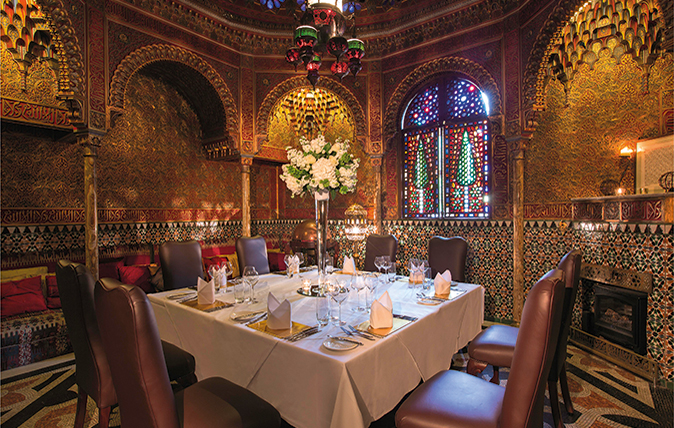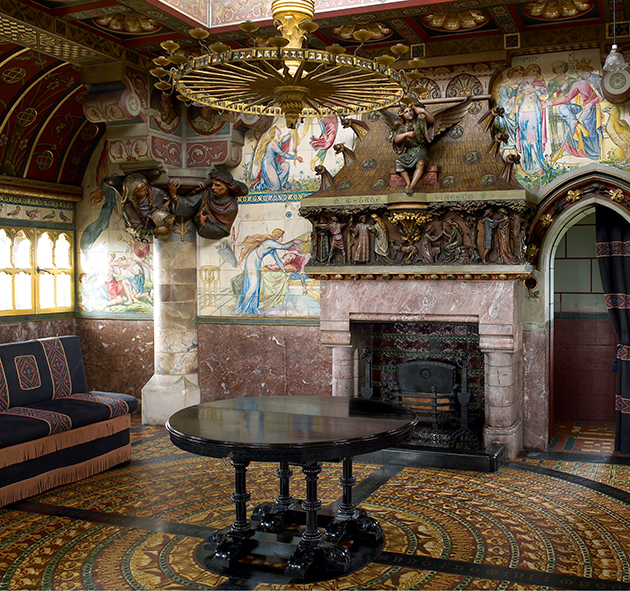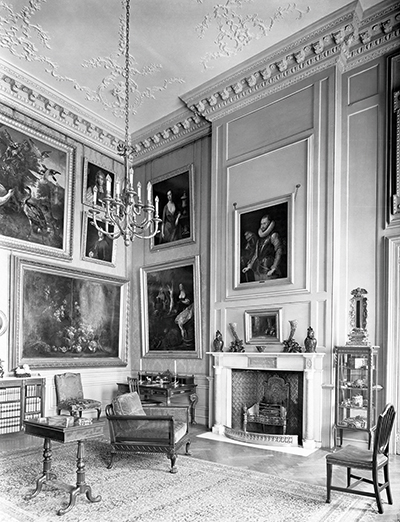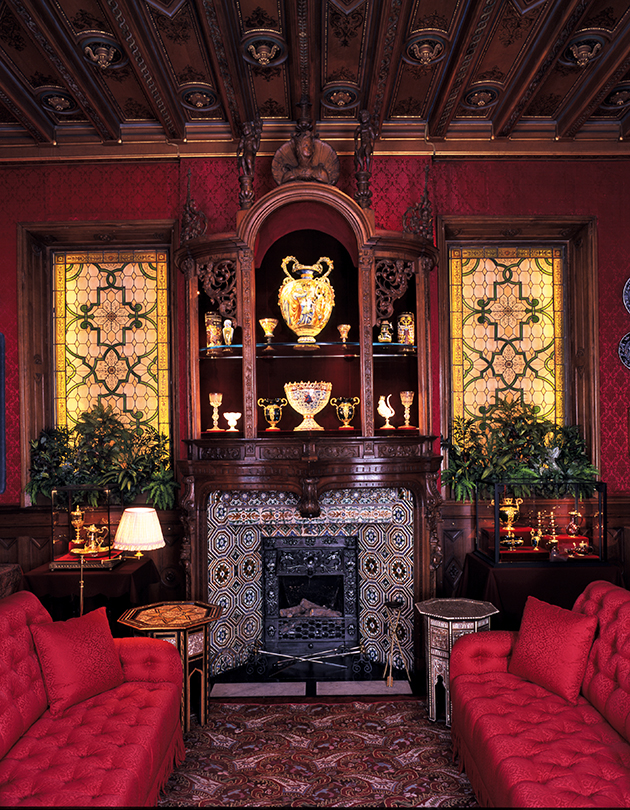The rise and fall of the smoking room, from essential feature to long-gone relic
By the 1880s, the smoking room had become an essential feature of the country house - Michael Hall examines the rise and fall of this masculine space


Every Tuesday we look into the Country Life architecture archives for a gem. This week it's Michael Hall's 2016 article on a once-popular domestic space that has now disappeared: the smoking room.
In the course of his disastrous interview with his future mother-in-law, Jack Worthing admits that he smokes.
‘I am glad to hear it,’ replies Lady Bracknell. ‘A man should always have an occupation of some kind.’
Oscar Wilde’s joke plays on the fact that, by 1895, when The Importance of Being Earnest was first performed, it was so commonplace for a man to smoke that it was scarcely worth mentioning, yet it had been an upper-class habit for barely half a century. Fashionable only from the early Victorian years, in the 1860s, pleasure in the ‘divine weed’ developed into a culture of connoisseurship. Men wrote odes and even novels about tobacco, collected the paraphernalia of smoking, adopted smoking caps and jackets and enjoyed their cigars in rooms designed for the purpose. By the 1880s, smoking rooms were ubiquitous.
They are not quite a Victorian invention. There were smoking rooms in the 17th and 18th centuries—for example, Kedleston Hall in Derbyshire had one in the 1760s. These were parlours where a gentleman might enjoy a pipe, perpetuating a tradition that had begun in Tudor times. One reason why they were relatively rare was that, by the 18th century, most aristocratic and middle-class people (women as well as men) preferred to enjoy tobacco in the form of snuff, which required no special setting. Smoking—usually with clay pipes, provided free in many taverns—had become largely a working-class habit.
That changed with the appearance of cigars in the first quarter of the 19th century. Most histories of smoking explain that they were introduced from Spain by army officers of the Peninsular War; however, many early comments on cigar smoking in Britain suggest that it was regarded as a German fashion. An early enthusiast was George III’s son Prince Augustus Frederick, Duke of Sussex, who may have started smoking as a student at Göttingen.
Although his after-dinner cigar was sufficiently unusual to be commented on with curiosity in the 1820s, by the time that another keen cigar smoker, Prince Albert, settled in England in 1840, the habit was common, although often not welcomed. Even Albert never smoked in the presence of his wife, who loathed tobacco. Such attitudes made it necessary to provide segregated spaces for smoking. In some country houses, anyone wanting a cigar could expect to be banished to the stables or even the servants’ quarters. Most, however, simply went out of doors. A conservatory, regarded as a semi-outdoor space, was an alternative and many early smoking rooms are close to conservatories.
Sign up for the Country Life Newsletter
Exquisite houses, the beauty of Nature, and how to get the most from your life, straight to your inbox.

One way to put cigar smoke well beyond even the most fastidious nostrils was to elevate the smoking room in a tower, exploiting the fact that, in the 1840s, towers had become fashionable in both Italianate and Gothic houses. The apotheosis of this plan is Cardiff Castle, where William Burges’s remodeling of the Clock Tower in 1869–73 for the then bachelor 3rd Marquess of Bute incorporated two smoking rooms, for winter below and for summer above. The latter is the most spectacular smoking room in existence, an incomparable Gothic Revival fantasy. An alternative position was next to a billiard room. Purpose-built billiard rooms were a Regency innovation and were habitually used or at least frequented by both sexes. That was one reason why they could not simply be allocated to smoking. In The Gentleman’s House (1864), Robert Kerr specifies that a billiard room should be placed ‘not exactly amongst the Dwelling- rooms, but still in close communication with them, for the access of the ladies’, adding that ‘it may be approached by a short balcony or covered way; but this is for smoking’. To Kerr, an entire room dedicated to smoking was a novelty and one that he did not entirely approve of to judge from his comment that it should have a pleasant view, as the smoker, on retreating to it, ‘ought to have some better excuse than the mere desire to smoke’.
Nonetheless, from the 1870s onwards, the increasing demarcation of country houses into separate male and female zones made the addition of a smoking room an attractive proposition, as, when grouped with a billiard room, a lavatory and perhaps a gun room, it formed part of a self-contained suite. Here, men could entertain themselves after dinner and enjoy not only a cigar or pipe, but also the sort of conversation from which women were excluded; the smoking room was a masculine retreat equivalent to the female domains of the morning room or boudoir.
In their decoration, most smoking rooms followed the tradition of rooms thought of as masculine spaces—not just billiard rooms, but also libraries, which were often, as Kerr points out, ‘primarily a sort of Morning-room for gentlemen rather than anything else’. Although accounts of smoking rooms focus on newly built houses, most were in old houses and converted from other uses. For example, COUNTRY LIFE’s 1927 photographs of Easton Neston show a first-floor panelled drawing room in use as a smoking room; it could just as easily be a small library.

The ideal model in most men’s minds for such rooms was probably the increasingly luxurious smoking rooms provided by London clubs. It is doubtful whether they cared much about the advice given in books on interior decoration that proliferated from late in the century, which stressed issues of hygiene and smells. For example, in The English Home (second edition, 1911), B. F. and H. P. Fletcher recommended that smoking- room ceilings should be enameled metal, so that the residue of smoke can be cleaned off ‘with a damp cloth’.
Some owners did indeed exclude textiles from smoking rooms as much as possible, to avoid lingering odours. The en-suite billiard and smoking rooms at Eaton Hall, Cheshire, designed by Alfred Waterhouse for the 1st Duke of Westminster, were fitted out, in the words of The Builder in 1880, with ‘wainscoted dados, with dark oak panels. The ceilings are also of wainscot, and the walls are hung with stamped leather. The floors are of parquet’. Just a few country-house smoking houses eschewed such masculine reserve.
Although the form of the Summer Smoking Room at Cardiff Castle is Gothic, the way of life it served was Eastern: its low divans, Turkish carpets and hookahs were typical of a long-standing European association between Islamic cultures and sensuous pleasure, seen as much in the Victorian Turkish bath as the smoking room. Both also, by implication at least, drew on Islamic traditions of strict separation between the sexes. One embodiment of this is the smoking room built for Sir Richard Wallace at Hertford House, London W1, in 1872–5. Only a fragment of its original decoration survived the conversion of the building into the Wallace Collection, but this is enough to convey the luxuriously colourful effect of its walls, lined with Minton’s imitations of Iznik tiles. The room was unusually large, reflecting the parallel social lives that Wallace was forced to lead because his demimondaine wife was not received in Society. In his smoking room, which had a separate entrance onto the street at the side of the house, his male peers could be entertained in private.
Even Wallace’s room was outdone for splendour by the Alhambra Room at Rhinefield House in the New Forest, built in 1888–90 and pictured at the top of this page. It was commissioned by Lt and Mrs Walker-Munro — her family’s colliery fortune paid for the house — partly as a memento of a visit to the Alhambra. Designed by W. H. Romaine-Walker, this enchanting English tribute to Islamic architecture is characteristic of his masterly handling of historic styles in combination with exotic materials—its octagonal dome is raised on marble pillars and the walls, covered in beaten copper, are inset with niches vaulted with honeycomb muqarnas.
The Rhinefield smoking room—well restored by the hotel that now occupies the house—is in a class of its own, but it represents a tradition to which many smoking rooms, such as Wallace’s, alluded, even if only with a Turkish rug or tourist-trophy hookah. Their furniture could evoke more general cosmopolitan associations. A rare depiction of a domestic smoking room in use, a cartoon published in Punch in 1886, depicts men occupying a basket chair (on the left) and a folding campaign chair (on the right), pieces of furniture that, to Victorian eyes, would have given the room a colonial or military atmosphere.
That idea is supported by a detailed description of a smoking room’s contents, ‘In a Traveller’s Smoking Room’, published in All the Year Round in November 1892. ‘It is not an ornate smoking room of the modern aesthetic pattern,’ writes the anonymous author, adding ‘valueless as are the contents… from a market point of view, to us, the collectors, they are priceless simply on account of the associations linked with each object.’ The writer goes on to describe these assorted objects gathered on his foreign travels, including an Alpenstock, a Japanese pilgrim bell, a Zulu war shield, a Roman figurine and a rosary and crucifix from Mont-Saint-Michel.
This offers a modest context for the best-known surviving smoking room, that at Waddesdon Manor, Buckinghamshire, fitted out in Renaissance style for Baron Ferdinand Rothschild. Part of a bachelors’ wing, and designed to be en-suite with a new billiard room, it was completed in 1880. It had a practical function, for entertaining the growing number of single male guests staying at the house, in part a consequence of Baron Ferdinand’s election to Parliament, but it had greater significance to him as the setting for his spectacular medieval and Renaissance goldsmiths’ work and jewellery.

On his death in 1898, he bequeathed this collection to the British Museum, where, as the Waddesdon Bequest, it has recently been re-housed in a magnificent new gallery (Country Life, July 8, 2015). The model for the room was the Renaissance-style private museums in the Parisian hotels of Baron Ferdinand’s French cousins, and no Englishman furnished his smoking room with so splendid a collection, but the pleasure Baron Ferdinand took in showing off his exquisite treasures was perhaps not very different in kind from the tales told by the author of ‘In a Traveller’s Smoking Room’ about his humble souvenirs. In artistic terms, Waddesdon’s smoking room is the final climax of the genre. As the increasing popularity of cigarettes from the 1880s onwards made smoking by women more socially acceptable, the smoking room began to drift into the main body of the house.
When Lutyens enlarged 18th-century Temple Dinsley, Hertfordshire, in 1908–9, he added a smoking room in enfilade with the drawing room and on the same scale—it might have been more accurate to have called the drawing room ‘the non-smoking room’. Soon, even this sort of arrangement seemed old-fashioned. In 1911, the Fletchers, in their book The English Home, quoted above, could say ‘some people do not object to smoking in any part of the house’.
By the mid century, when about 80% of men and 40% of women smoked, almost nobody did and the smoking room faded away. Now that smoking is once again a much-disapproved of minority activity, might it be ready for a renaissance?
Country Life is unlike any other magazine: the only glossy weekly on the newsstand and the only magazine that has been guest-edited by HRH The King not once, but twice. It is a celebration of modern rural life and all its diverse joys and pleasures — that was first published in Queen Victoria's Diamond Jubilee year. Our eclectic mixture of witty and informative content — from the most up-to-date property news and commentary and a coveted glimpse inside some of the UK's best houses and gardens, to gardening, the arts and interior design, written by experts in their field — still cannot be found in print or online, anywhere else.
-
 ‘If Portmeirion began life as an oddity, it has evolved into something of a phenomenon’: Celebrating a century of Britain’s most eccentric village
‘If Portmeirion began life as an oddity, it has evolved into something of a phenomenon’: Celebrating a century of Britain’s most eccentric villageA romantic experiment surrounded by the natural majesty of North Wales, Portmeirion began life as an oddity, but has evolved into an architectural phenomenon kept alive by dedication.
By Ben Lerwill
-
 Never leave a bun behind: What to do with leftover hot cross buns
Never leave a bun behind: What to do with leftover hot cross bunsWhere did hot cross buns originate from — and what can do with any leftover ones?
By Amie Elizabeth White